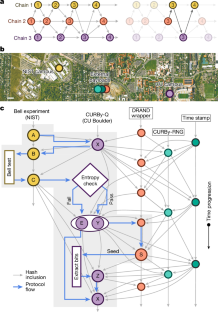非局部量子优势的可追踪随机数
IF 48.5
1区 综合性期刊
Q1 MULTIDISCIPLINARY SCIENCES
引用次数: 0
摘要
随机数的不可预测性是数字安全1,2和公平分配资源的应用程序3,4的基础。然而,现有的随机数生成器有其局限性——生成过程不能被完全跟踪、审计和认证为不可预测的。伪随机数生成器5中使用的算法步骤是可审计的,但它们不能保证在给定初始种子的情况下,它们的输出是先验的不可预测的。与设备无关的量子随机数生成器6,7,8,9可以确保事先不知道随机性的来源,但用于提取随机性的步骤容易被篡改。在这里,我们展示了一个基于设备无关技术的完全可追溯的随机数生成协议。我们的协议从不可预测的非局部量子关联中提取随机性,并使用分布式交织哈希链加密跟踪和验证提取过程。该协议构成了我们已经启动的公共可追溯和可认证的量子随机信标的基础。在前40天的手术中,我们完成了7454次尝试中的7434次,成功率为99.7%。每次协议成功时,信标发出一个512位的可追踪随机性脉冲。用误差乘以以2−64为界的实际成功概率证明比特是均匀的。可证明和可追溯的随机性的产生代表了一种公共服务,它比可比的经典方法具有纠缠衍生的优势。本文章由计算机程序翻译,如有差异,请以英文原文为准。


Traceable random numbers from a non-local quantum advantage
The unpredictability of random numbers is fundamental to both digital security1,2 and applications that fairly distribute resources3,4. However, existing random number generators have limitations—the generation processes cannot be fully traced, audited and certified to be unpredictable. The algorithmic steps used in pseudorandom number generators5 are auditable, but they cannot guarantee that their outputs were a priori unpredictable given knowledge of the initial seed. Device-independent quantum random number generators6–9 can ensure that the source of randomness was unknown beforehand, but the steps used to extract the randomness are vulnerable to tampering. Here we demonstrate a fully traceable random number generation protocol based on device-independent techniques. Our protocol extracts randomness from unpredictable non-local quantum correlations, and uses distributed intertwined hash chains to cryptographically trace and verify the extraction process. This protocol forms the basis for a public traceable and certifiable quantum randomness beacon that we have launched10. Over the first 40 days of operation, we completed the protocol 7,434 out of 7,454 attempts—a success rate of 99.7%. Each time the protocol succeeded, the beacon emitted a pulse of 512 bits of traceable randomness. The bits are certified to be uniform with error multiplied by actual success probability bounded by 2−64. The generation of certifiable and traceable randomness represents a public service that operates with an entanglement-derived advantage over comparable classical approaches. A study demonstrates a public generator of random numbers based on device-independent techniques, with the randomness being fully auditable and traceable.
求助全文
通过发布文献求助,成功后即可免费获取论文全文。
去求助
来源期刊

Nature
综合性期刊-综合性期刊
CiteScore
90.00
自引率
1.20%
发文量
3652
审稿时长
3 months
期刊介绍:
Nature is a prestigious international journal that publishes peer-reviewed research in various scientific and technological fields. The selection of articles is based on criteria such as originality, importance, interdisciplinary relevance, timeliness, accessibility, elegance, and surprising conclusions. In addition to showcasing significant scientific advances, Nature delivers rapid, authoritative, insightful news, and interpretation of current and upcoming trends impacting science, scientists, and the broader public. The journal serves a dual purpose: firstly, to promptly share noteworthy scientific advances and foster discussions among scientists, and secondly, to ensure the swift dissemination of scientific results globally, emphasizing their significance for knowledge, culture, and daily life.
 求助内容:
求助内容: 应助结果提醒方式:
应助结果提醒方式:


